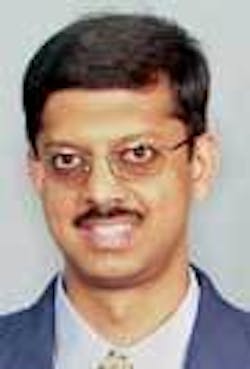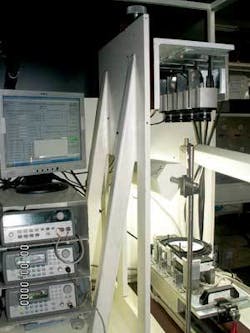Global perspective drives local products and services
A discussion with Ganesh Devaraj, Soliton Technologies
Ganesh Devaraj is managing director and CEO of Soliton Technologies (Bangalore, India; www.solitontech.com). He has a bachelor’s degree in electronics and communications engineering from PSG College of Technology, Coimbatore, and an M.S. in electrical engineering and Ph.D. in theoretical particle physics from the University of Michigan. He worked as a project scientist at VI Engineering before returning to India to start Soliton in 1998. Editor in chief Conard Holton spoke to him about OEM products and system integrators in India.
VSD: How does the machine-vision market differ in India from that of the United States in terms of OEM suppliers and system integrators?
Devaraj: The market in India is an emerging market with low volumes relative to its GDP. Current growth in the machine-vision market in India is a reflection of the quality movement in the manufacturing industry, driven by higher competition in the Indian market with the entry of global brands and increased exports from Indian manufacturers to the global market.
Due to the history of low demand for vision systems in the Indian market, there has been very little growth of system integrators and no recognized OEM suppliers. Today, there is a significant demand for machine-vision system integration in India, but generally poor understanding as to what requirements can be effectively addressed at what costs using the technology. It will take a few years for the industry’s understanding and expectations to mature and a set of established system integrators to emerge.
Soliton is the first Indian manufacturer and OEM supplier of machine-vision components. We are currently supplying board-level cameras, as well as complete cameras preloaded with application-specific image-processing algorithms running on the onboard FPGA. Applications include automotive garage equipment and food processing. The OEM market in India typically requires significant handholding and support during the development of solutions. OEMs expect to pay the NRE (nonrecurring engineering) cost at engineering rates that are prevalent in the Indian market-less than a third to a fourth of the costs in the USA. The majority of the current equipment needs in the industry are fulfilled by importing fully finished equipment.
VSD: What systems or services does your company provide that allow you to compete in this market?
Devaraj: Soliton started providing machine-vision system-integration services in the Indian market in 1998. In 2003, we incorporated a subsidiary company in Milwaukee, WI, and started providing system-integration services in the US market. We achieved success with many repeat systems, especially in the automotive industry. And we also received international awards for an automated inspection system developed for a global medical-equipment manufacturer and for an automated system for inspecting automotive brake assemblies.
In 2002, we had started developing a camera for an OEM application. By 2004, with the machine-vision market expanding across India, we decided to manufacture machine-vision cameras and smart cameras and to address the growing Indian market with a network of geographically distributed system-integration partners. Some of our experiences in India convinced us that the Indian market would benefit from and be receptive to a domestic manufacturer of cameras. Soliton’s primary differentiators are our better understanding of the local industry’s need, significantly lower NRE costs for OEM supplies, and post-sales support with a 48-hour repair/replacement assurance.
VSD: Do you specialize in certain applications or supply systems for a variety of industries? Which industries are predominant users of machine vision in India?
Devaraj: Our catalog machine-vision cameras are suitable for a wide range of industries. We do develop OEM cameras and software algorithms for specific applications on an exclusive or nonexclusive basis depending on the contract with our customer. For OEM applications, we are expanding our partnerships with system-integration companies with specific domain expertise so that we can focus on providing the specialized imaging and image-processing components and our partners will provide the rest of the components including mechanical handling, application software, and the system-level validation required by our OEM customers. The industries that we have seen adopting machine vision in India are automotive, pharmaceutical, textile, and food processing, along with process industries, such as steel.
VSD: What types of components and network interfaces do you use? How often do you evaluate competing technologies?
Devaraj: We have used analog and FireWire cameras from Sony Electronics (Park Ridge, NJ, USA; www.sony.com/videocameras), FireWire cameras from Basler (Ahrensburg, Germany; www.baslerweb.com), and Camera Link linescan cameras from DALSA (Waterloo, ON, Canada; www.dalsa.com). We have always found the specifications we needed in the frame grabbers from National Instruments (NI; Austin, TX, USA; www.ni.com).
For processing, we have usually chosen a desktop PC running Windows because of its low cost, good processor speed, and the availability of software tools. In environments where a PC is not suitable, we have used the Compact Vision System from NI. When we have to integrate systems with multiple plug-in cards such as GPIB, CAN, DAQ, or DIO, we prefer the PXI platform. LabVIEW and the image-processing tools from NI have been our software programming platform of choice, primarily because of our familiarity with them and also because we have been able to address all the applications we have attempted to date using the NI IMAQ Vision Tools.
In none of the installations that we have done has the customer asked for integrating the inspection station into their factory information network, even when they have an ERP (enterprise resource planning) system in place. The tools from NI have served us well and so we have not evaluated competing technologies. Now that we are making cameras we will be making our products compatible with frame grabbers and software from other companies.
VSD: In which areas do you see the most growth? What are users demanding from you in the design of new systems?
Devaraj: So far most of our sales have come from turnkey systems costing at least $40,000 that include material handling with complete automation. The low labor cost in India compared to the countries with developed economies reduces the number of potential opportunities for automated inspection. The opportunities typically lie in regulated industries such as pharmaceutical, industries where quality demands are very high such as automotive, and in situations where many manual inspectors can be replaced with one automated system, such as high-volume pencil inspection in which one automated system we delivered running round the clock replaced 30 manual inspectors.
We see significant demand for very-low-cost inspection systems that are about a few thousand dollars, but most often there is a significant mismatch between what the customer requires the system to be able to handle and what a system at that price can actually be configured to do. The challenge lies in bridging this gap without increasing the price.
VSD: How will OEM components targeted toward machine-vision applications have to change to meet future needs?
Devaraj: OEM customers want to be able to differentiate while leveraging the low cost of standardized products. This implies standard versatile hardware components with software that is user-friendly for the OEMs to program while providing the flexibility of a low-level programming language. This can be achieved with application-specific libraries supplied with hardware to OEM customers. Another attribute that we feel is important is the ability to replace failed cameras with negligible setup time. The automated equipment that we have developed for testing our cameras gives a measure of the uniformity between our golden reference camera and the one under test to address this issue.
VSD: Could you compare the machine-vision markets in different industry segments in India?
Devaraj: The electronics industry in India is small in relation it its neighbors in Southeast Asia, but it is growing, with more global companies setting up manufacturing facilities in India. Nokia and its suppliers are investing $300 million in a new facility. The semiconductor industry is getting off the ground with a $3 billion fab. The AOI systems for these facilities are being imported from established foreign vendors.
The automotive-component suppliers handle high volumes and face high quality demands from automobile manufacturers, making quality control and assurance an important activity. But the variability in the inspection tasks when components change, combined with the low labor costs, presents a barrier to the large-scale adoption of machine vision. We are working closely with a few large tier-1 suppliers along with our partners to identify and develop specific products that present a compelling value proposition.
There is a large pharmaceutical industry in India that manufactures generics for the global market. Being a regulated industry with tight quality norms, the industry has been an early adopter of automated inspection. In addition, the OEMs in the textile and food-processing industries are significant buyers of cameras. Cotton-contamination detection and removal equipment and color sorters for rice and other foods are some proven vision applications.
VSD: How do you approach new applications? Can you discuss NRE and deployment costs?
Devaraj: Soliton intends to address the application requirements through our system-integration partners. We have launched a program, the Soliton Machine Vision Partner Program, to identify and partner with the most capable engineering-services firms in India that are either already deploying vision systems or are interested in becoming vision-system integrators and to share our learning gained from more than eight years of experience in system integration. This will be through a combination of customized training and ongoing application consulting. We endeavor to ensure that our cameras are successful in the applications handled by our partners and believe that we can attract and establish a partner network that contains the very best vision-system integrators in India.
While the NRE per-hour costs are low, the deployment costs in India can grow large if requirements and validation criteria are not tied down at the start of the project. This is especially true of the Indian industry because its experience with vision projects is limited and expectations are often unreasonable.
VSD: What kinds of new applications do you expect to emerge in the future?
Devaraj: I expect that novel applications specific to the Indian manufacturing industry will emerge in the next year or two. While in developed countries factories have become highly automated, in India there is a lot of manual labor. With the cost of the cameras coming down and the computing capabilities going up much faster than the cost of the labor, some new paradigms may emerge. If we stay engaged with our customers and keep an eye on scientific developments that impact machine vision, we believe that we should be able to deliver innovative products and applications that make a significant difference to our customers.
VSD: Why are you moving toward developing your own OEM products?
Devaraj: Our experiences during system integration in India convinced us that there is a significant advantage to manufacturing cameras in India. Every time we faced a camera failure, the time it took us to ship the camera through the Indian customs for repair and the re-import without paying the customs duties for the second time involved a huge amount of paper work and time. The typical turn around time was two months for a repair and return! Second, during the development of OEM applications, the NRE costs we incurred when we wanted custom engineering work to be done were expensive by Indian standards and cumbersome due to the distance.
This prompted us in 2002 to develop our own camera for an OEM application, but our primary focus continued to remain in system integration. In 2004, we made the decision to exit from the system-integration market to focus on product development and partner with a network of system integrators in India to expand our reach into the geographically spread Indian market.
It is our goal to significantly grow the machine-vision market in India with innovative products that are especially suited to the needs of the industry here. Our mission is to establish ourselves as the best known and most respected brand in India for machine-vision imaging hardware and image-processing software products.


